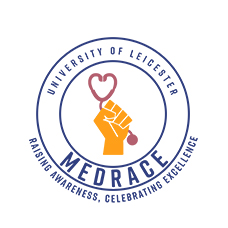College of Life Sciences
Resources for Educators
Diverse images
In addition to the linked articles and papers throughout this toolkit and references, below follow a number of resources for sourcing more diverse images. An inclusive curriculum is of course about more than just diversity of images, though this is of course an important – and often easy to incorporate – aspect of inclusive learning resources. It is essential that these form the core of our teaching and are not simply referenced or buried away in references or further reading, where the likelihood of it contributing to learning will be diminished.
Our toolkit also provides recommendations from student-selected components (SSCs) in specific pre-clinical and clinical subject areas, though lessons can of course be drawn from these for similar inclusive changes across the curriculum.
| Resource name/link | Brief description | Author/source |
| Atlas of Black Skin | This is perhaps the largest resource for pathological signs in darker skin, and is available online through our library | Moiin, A. (2020) |
| Mind the Gap: A clinical handbook of signs and symptoms in black and brown skin | This is an excellent (free) resource developed by Malone when a medical student, and has a good selection of clinical signs in darker skin. | Mukwende, M. (2020) |
| Skin of Colour Image Atlas | Another good (online) atlas for images with skin of colour | Journal of the American Academy of Dermatology |
| https://brownskinmatters.com/ | A free community sourced database with pathology in darker skin | Weiss, E. (2018) |
| Skin of colour in dermatology education | The British Association of Dermatology has also collated several resources for skin of colour | British Association of Dermatology |
Searching the primary literature (with appropriate key words) can be a good way of finding images of signs for particular conditions, often in case studies (e.g. limb ischaemia in dark-skinned patients)
Projects and further work
This is the beginning of our work to challenge exclusions and create a real sense of belonging for everyone. We hope that these examples and ideas begin to highlight some ways in which we all might gradually incorporate similar changes across our learning environment. The SSC curriculum inclusion projects – and review of their implementation as part of a student-led ‘Seeing the Change’ project - will continue to be offered. We recognise that this is but one aspect of a whole institution approach towards active inclusion which will include:
- Continued implementation of our EDI longitudinal curriculum theme
- Ongoing engagement and co-creation with students through existing governance structures and groups (MedRACE, medical school EDI committee etc.)
- Working with the Executive team, College and central University to ensure a whole institution approach towards active inclusion and challenging exclusions
- Quality Assurance through alignment with GMC, MSC, BMA and other national frameworks and review of local feedback
Modification of data collection methods to better collect more granular data on concerns around discrimination within the learning environment - Improved responsiveness to student and staff queries and concerns through regular feedback and updates to both via student-staff liaison committee meetings and whole School meetings (and to the School Education Committee and Executive), as well as the creation of an FAQ document on racial inclusion in the curriculum.
References and further reading
1. Dogra N, Bhatti F, Ertubey C, Kelly M, Rowlands A, Singh D, et al. Teaching diversity to medical undergraduates: Curriculum development, delivery and assessment. AMEE GUIDE No. 103. Med Teach. 2016;38(4):323-37.
2. Gishen F, Lokugamage A. Diversifying the medical curriculum. BMJ. 2019;364:l300.
3. Lester JC, Taylor SC, Chren MM. Under-representation of skin of colour in dermatology images: not just an educational issue. Br J Dermatol. 2019;180(6):1521-2.
4. Mbaki Y, Todorova E, Hagan P. Diversifying the medical curriculum as part of the wider decolonising effort: A proposed framework and self-assessment resource toolbox. Clin Teach. 2021;18(5):459-66.
5. Moghli MA, Kadiwal L. Decolonising the curriculum beyond the surge: Conceptualisation, positionality and conduct. London Review of Education.19(1).
6. Wong SHM, Gishen F, Lokugamage AU. ‘Decolonising the Medical Curriculum‘: Humanising medicine through epistemic pluralism, cultural safety and critical consciousness. London Review of Education.19(1).
7. Woolf K, Potts HW, McManus IC. Ethnicity and academic performance in UK trained doctors and medical students: systematic review and meta-analysis. BMJ. 2011;342:d901.
8. Medical Schools Council EDI Alliance. Active inclusion: Challenging exclusions in medical education. 2021.
9. Shirley MH, Barnes I, Sayeed S, Finlayson A, Ali R. Incidence of breast and gynaecological cancers by ethnic group in England, 2001-2007: a descriptive study. BMC Cancer. 2014;14:979.
10. Konings KD, Mordang S, Smeenk F, Stassen L, Ramani S. Learner involvement in the co-creation of teaching and learning: AMEE Guide No. 138. Med Teach. 2021;43(8):924-36.
11. Forrest D, George S, Stewart V, Dutta N, McConville K, Pope L, et al. Cultural diversity and inclusion in UK medical schools. Clin Teach. 2022.
12. Kmietowicz Z. Are medical schools turning a blind eye to racism? BMJ. 2020;368:m420.
13. Cerdena JP, Plaisime MV, Tsai J. From race-based to race-conscious medicine: how anti-racist uprisings call us to act. Lancet. 2020;396(10257):1125-8.
